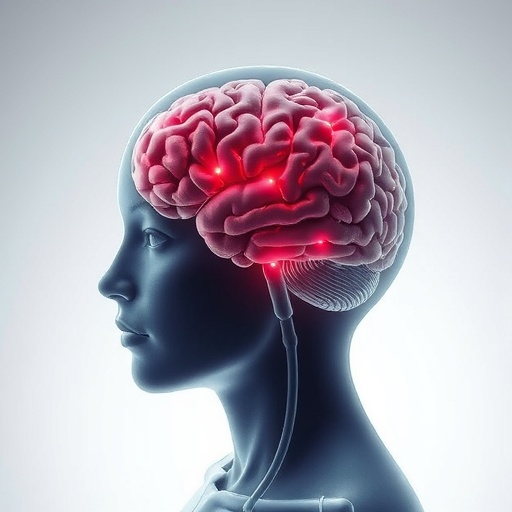In a groundbreaking case report published in BMC Psychiatry, researchers have detailed the intriguing intersection between obsessive-compulsive disorder (OCD) and temporal lobe porencephaly, a rare structural brain abnormality. This study sheds new light on the neurobiological underpinnings of OCD, particularly when linked to developmental anomalies within the temporal lobe, a region traditionally underexplored in the context of this complex psychiatric disorder.
Obsessive-compulsive disorder, characterized by intrusive thoughts and repetitive behaviors, has long been associated with dysfunction in the cortico-striato-thalamo-cortical (CSTC) circuits. These neural pathways integrate motor, cognitive, and emotional processes, and their dysfunction is believed to underlie the symptomatic manifestations of OCD. However, the role of temporal lobe structures has remained obscure, with most neurobiological theories fixated on the frontostriatal circuitry. This case presents compelling evidence that temporal lobe pathology might contribute significantly to OCD symptoms.
The subject at the core of this report is a young male exhibiting classic obsessive-compulsive symptoms while harboring a unique cerebral abnormality known as temporal lobe porencephaly. Porencephaly refers to the presence of cystic cavities or fluid-filled spaces within the brain tissue that arise due to developmental disruptions or perinatal injuries. The location and extent of such abnormalities can drastically influence neuropsychological functions, as the temporal lobe is integral for memory, emotion regulation, and sensory integration.
Interestingly, despite the structural damage caused by porencephaly, the patient maintained relatively intact cognitive functions and preserved social capabilities. This dissociation challenges common assumptions that organic brain lesions necessarily lead to severe cognitive deficits. Instead, it suggests a nuance in how certain brain injuries may selectively disrupt neural circuits implicated in psychiatric manifestations such as OCD, without broadly impairing cognition.
Therapeutic interventions in this case involved administering selective serotonin reuptake inhibitors (SSRIs) such as sertraline and fluvoxamine, paired with the atypical antipsychotic aripiprazole. SSRIs remain the cornerstone of OCD treatment due to their modulation of serotonergic pathways, which influence the CSTC circuits. The patient’s symptomatic improvement upon pharmacological intervention reinforces the value of these agents even in cases where structural brain abnormalities are present.
However, the clinical journey was complicated by multiple relapses following medication withdrawal, highlighting the chronic and often refractory nature of OCD when intertwined with neurodevelopmental abnormalities. Reinstating the treatment regimen resulted in sustained symptomatic control, underscoring the necessity of continuous maintenance therapy in organic forms of OCD to prevent relapse and maintain quality of life.
This case is singular in that it is reportedly the first documented instance linking left temporal lobe porencephaly directly with obsessive-compulsive disorder. Such documentation is pivotal for the psychiatric community as it expands the spectrum of organic contributors to OCD, urging clinicians and researchers to consider structural brain anomalies in cases exhibiting atypical symptomatology or resistance to conventional treatments.
The pathophysiological mechanisms connecting temporal lobe porencephaly to OCD are yet to be fully elucidated. One postulated hypothesis involves disordered connectivity and aberrant signaling within the temporal lobe disrupting interactions with CSTC circuits. Given the temporal lobe’s role in processing sensory information and emotional salience, its impairment might amplify intrusive thoughts or ritualistic behaviors characteristic of OCD.
Further research is imperative to decode the intricate interplay between temporally localized brain lesions and obsessive-compulsive symptom emergence. Functional neuroimaging studies, alongside longitudinal clinical assessments, could unravel how these lesions interfere with neural network dynamics over time, providing insights for targeted therapeutic approaches.
Additionally, this case prompts a re-evaluation of current diagnostic frameworks, advocating for incorporating structural neuroimaging more routinely in OCD assessments, especially when clinical presentation is atypical or resistant to treatment. This approach could aid in identifying potential organic contributors, enabling personalized treatment plans blending pharmacotherapy with neurorehabilitation strategies.
The implications also extend to prognosis and long-term management. Understanding that organic OCD may respond differently to pharmacological interventions necessitates tailored maintenance strategies, emphasizing adherence to medication and vigilance for relapse. Moreover, integrating psychosocial support remains crucial for preserving social functioning and mitigating the disorder’s impact on daily living.
In sum, this novel case report disrupts existing paradigms by highlighting the potential role of temporal lobe structural abnormalities in the pathogenesis of OCD. It bridges the gap between neurodevelopmental brain disorders and psychiatric conditions, opening avenues for interdisciplinary research and clinical innovation. The findings encourage a more nuanced appreciation of OCD’s heterogeneity, encompassing both functional circuitry disruptions and structural brain pathology.
As neuroscience and psychiatry converge further, such integrative case studies illuminate hidden dimensions of mental illnesses, inspiring hope for novel diagnostic and therapeutic horizons. The journey from a rare porencephalic lesion to a better understanding of OCD exemplifies the complex dialogue between brain structure and behavior—a dialogue continually reshaped by relentless scientific inquiry.
Subject of Research: Obsessive-compulsive disorder in relation to temporal lobe porencephaly; neurobiological basis of OCD with structural brain abnormalities.
Article Title: Obsessive-compulsive disorder and temporal lobe porencephaly: a case report
Article References:
Deng, G., Cao, Y. & Qiu, C. Obsessive-compulsive disorder and temporal lobe porencephaly: a case report. BMC Psychiatry 25, 341 (2025). https://doi.org/10.1186/s12888-025-06774-8
Image Credits: AI Generated




